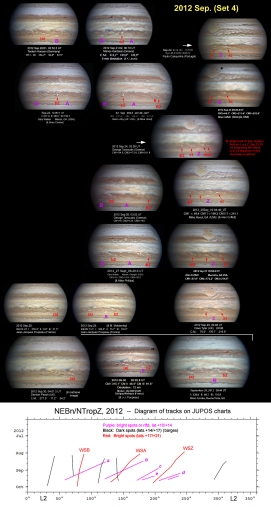[6] Renewal of rift activity in the revived NEB:
| ||||
|---|---|---|---|---|
|
Japanese
This set of images from 2012 Aug.21 to Sep.30, displayed across 4 panels, shows the renewal of rift activity in the revived NEB, along with Oval BA passing the GRS, and other features in that hemisphere. In the SEB, note a very dark brown barge at L2=95; the long-lived light spot at L2=115; the GRS at L2=183, with red oval BA passing it; and the normal energetic rifting in the SEB f. it. In the NEB, note the barges and ovals developing as mentioned in our previous report. The 4th panel includes a chart showing their drifts, derived from the JUPOS team’s charts. The three anticyclonic ovals are still light grey rather than white, but we refer to them as white spots B, A, and Z, as in our previous report. They are at 19 deg.N. WSA and WSZ are rapidly prograding. The barges are much smaller, dark spots, slow-moving, at L2~35, 70, 112, 140. WSA passed the last barge around Sep.10-12, as is nicely shown in the images (the barge became a tiny dark point at the time). The main novelty is that, since late August, new bright spots have been appearing within the NEB, which was previously devoid of bright spots or rifts due to the small-scale turbulence of the NEB Revival. Several observers pointed out these small, bright white points and remarked that they were exceedingly bright. They stand out particularly in blue or UV images. Nevertheless, they are only weakly methane-bright even at their first appearance (one on Sep.8, one on Sep.16), and are otherwise not methane-bright; so they are not shooting up very high. These brilliant white points expand over a few days, as usual, into curling rifts, which become more complex but less bright. They drift at ~-2.0 deg/day in L2. But later, new brilliant white points sometimes appear on the same track. So the 5 spots/rifts labelled on the images (a,b,c,d,e) seem to be the persistent loci even though successive bright points appear within them. The bright points range in latitude from ~12.5 to 14 deg.N. Is there any relationship between the bright points and the barges? The first bright point (a) was first distinctly seen on the S edge of the barge at L2=112 (Aug.21). But thereafter, there is no sign of any relationship. Often a bright spot has a very dark brown N rim, similar to a barge in colour and latitude, even when there is no persistent barge there. On two occasions, a brilliant white point appeared to be almost stationary in L2 (and almost exactly N of the GRS!) for several days: spot e (Sep.8-13 or 11-13) and spot d1 (Sep.22-29). This might be due to their northerly latitude at the time (14 deg.N) . Or, each might represent a sequence of very short-lived plumes instead of a single static one. These new rifts may be a renewal of the usual rifting activity in the NEB, which along with the new barges and ovals, is another sign that the NEB Revival is complete, although one-third of the circumference still lacks any of these spots. All these classes of spots will probably continue to develop over the coming months.
| ||||
Click images below for full resolution images:
| ||||
|
_______________________________ John H. Rogers, Ph.D. Jupiter Section Director, British Astronomical Association jhr11@cam.ac.uk http://www.britastro.org/jupiter/ _________________________________
| ||||
[6] 復活したNEBのリフト活動の再開、2012年8-9月の大赤斑半球の画像
| ||||
|
4つのパネルにまたがって表示されている、2012年8月21日〜9月30日のこれらの画像は、復活したNEBのリフト活動の再開と、大赤斑を通過している白斑BAや、この半球の別の模様も一緒に示している。 SEBには、L2=95度に非常に濃い茶色のバージ、L2=115度に長寿命な明るい白斑、L2=183度に大赤斑と大赤斑を通過している赤い白斑BA、大赤斑後方のSEBに通常の活動的なリフトが注目される。 NEBには、我々の以前のレポートで述べたように発達しているバージと白斑が注目される。4番目のパネルには、JUPOSチームのチャートから導かれた、これらのドリフトを示すチャートが含まれる。3個の高気圧性白斑は今も白色というよりは明るい灰色であるが、以前のレポートと同様に、これらを白斑B,A,Zとして参照する。これらの白斑は北緯19度にある。WSAとWSZは急速に前進している。バージはさらに小さく、暗斑で、ゆっくりと移動し、L2=約35,70,112,140度に位置する。画像に良く見られるように、WSAは9月10-12日頃に最後のバージを通過した(その時にバージは小さな暗点になった)。 主な目新しいことは、NEB復活の小規模な乱流に起因する白斑やリフトが以前には存在していなかったNEB内部に、8月下旬以降新しい白斑が出現していることである。何人かの観測者は、これらの小さな明るい点を指摘していて、それらが非常に明るかったと述べている。それらは青色かUV画像で特に目立っていた。にも関わらずに、それらは最初の出現(一つは9月8日、一つは9月16日)時でさえ弱いメタンブライトであり、そうでなければメタンブライトではない。だから、これらは非常に高くに打ち上げられていない。 これらの明るい白点は通常は曲がったリフト内で数日間は拡がり、より複雑になるが明るくはならない。これらはL2に対して約-2.0度/日でドリフトしている。しかし、後には新しい明るい白点が同じ追跡上に出現している。だから、画像に(a,b,c,d,e)とラベルを付けた5点/リフトは、連続した輝点がリフト内部に出現しているにも関わらずに、持続した場所のように思われる。輝点は北緯約12.5度〜14度の範囲である。 輝点とバージには何か関係があるのか。最初の輝点(a)はL2=112度のバージの南端に初めははっきりと見えていた(8月21日)。しかし、その後は関係の証拠はない。永続的なバージが存在しない時でさえ、しばしば明るい白斑は、色や緯度がバージと同様な、非常に濃い茶色の北側のリムがある。二度、明るい白点が数日間はL2に対してほとんど静止(ほとんど大赤斑の真北に)していたように見えた【輝点e(9月8-13日または11-13日)、輝点d1(9月22-29日)】。これはその時の北側緯度(北緯14度)によるものかもしれない。あるいは、それぞれが単一の静的な白斑の代わりに非常に短命なプルームの並びを表しているかもしれない。 これらの新しいリフトはNEBの通常のリフト活動であるかもしれない。全周の1/3はまだこれらの白斑はないけれども、新しいバージと白斑が一緒にあることは、NEB復活が完全であるもう一つの証拠である。白斑のこれらのクラス全ては今後数ヵ月はおそらく発達し続けるだろう。
| ||||
Click images below for full resolution images:
| ||||
|
_______________________________ John H. Rogers, Ph.D. Jupiter Section Director, British Astronomical Association jhr11@cam.ac.uk http://www.britastro.org/jupiter/ _________________________________ 【日本語訳:伊賀祐一】 |



